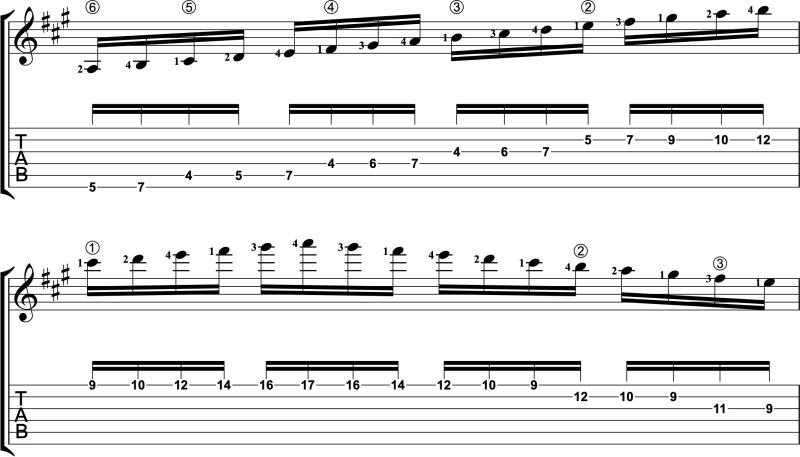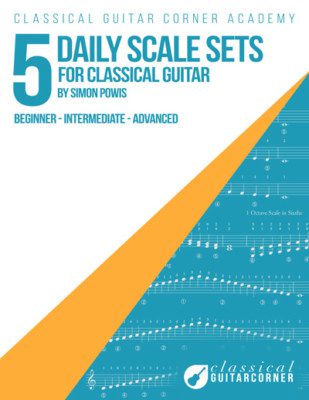Learn to Play an A Major Scale on Guitar
In this article we’ll walk you through how to play an A Major scale on the guitar.
A Major Guitar Scale Notes
The A Major scale consists of the following notes:
A-B-C#-D-E-F#-G#-A
Notice there are three sharps, which is a lot to keep track of. Luckily we have a nice reminder of which notes are sharp at the beginning of each line.
Key Signature
The key signature, located at the beginning of each line or system, has three sharps: F#, C#, G#. This saves space on the score and reminds us which notes are accidentals and which are natural.
A Major Scale One Octave
We can play the one-octave A Major scale in two different places on the guitar. First, we can play it in first position with a combination of open strings and fretted notes. Let’s start there. Remember that a “position” in classical guitar is dictated by where your first finger plays. Go here for a refresher on playing in positions.
First Position

Second Position
But we can also play this same one-octave scale with no open strings in second position.

A Major Scale Two Octaves
We can play a two-octave A Major scale starting in different positions as well. Here we’ll look at playing in (mostly first position to start).
First/Second Position
This is “mostly” in first position because you do have to shift to second position temporarily. To make the shift easier we will shift on the open first string. Shifting on an open string gives you a tiny bit more time to get your hand in position before it has to play again.

Fifth Position
We can also play the full two-octave A Major scale entirely in fifth position without having to shift at all. However, we will need to use what is known as an “extension” on the fourth string. An extension allows us to reach a note out of position by stretching with our fingers. Go here for a refresher on extensions.

A Major Scale Three Octaves
The three-octave A Major scale is quite advanced and if you play it in sixteenth notes, like below, it is even quite virtuosic. However, the fingering provided below minimizes the number of shifts you need to make, even as you ascend to the 17th fret and back!

A Major Scale in Classical Guitar Repertoire
A Major is a very guitar-friendly key and so it appears in the repertoire all over the place. Here are some great pieces featuring A Major and the A Major scale:
Exercise 7 by Aguado
Etude 3 by Carcassi
Sonata K.322 by Scarlatti
Sonata K.208 by Scarlatti
***
We hope you’ve enjoyed learning the A Major scale! Want to learn more scales?
- Check out our Scales Resources page.
- Get started with how to play a C Major scale on guitar.
- Download a FREE Scales Book –>


Leave A Comment